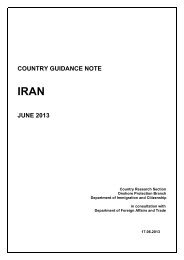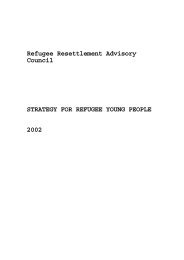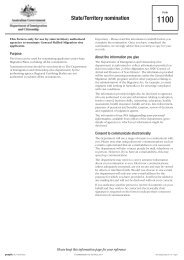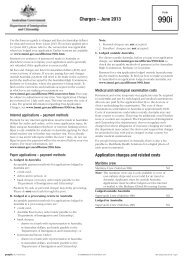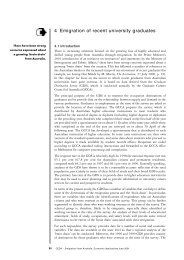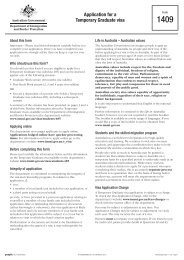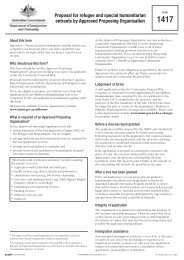Evaluation of the Integrated Humanitarian Settlement Strategy (IHSS)
Evaluation of the Integrated Humanitarian Settlement Strategy (IHSS)
Evaluation of the Integrated Humanitarian Settlement Strategy (IHSS)
You also want an ePaper? Increase the reach of your titles
YUMPU automatically turns print PDFs into web optimized ePapers that Google loves.
4 Issues for <strong>the</strong> <strong>IHSS</strong><br />
This section addresses Terms <strong>of</strong> Reference numbers 1, 3, 4 and 5. It also examines additional<br />
perceived impediments to effective and efficient service delivery commonly raised by stakeholders,<br />
primarily service providers.<br />
The points made in this section are <strong>of</strong> a global kind, ie relating to all or many <strong>of</strong> <strong>the</strong> parts <strong>of</strong> <strong>the</strong> <strong>IHSS</strong><br />
service. Reference is made by way <strong>of</strong> examples to individual services. However more detailed<br />
consideration <strong>of</strong> issues relating to individual services is reserved for a separate section <strong>of</strong> this report<br />
(section 5).<br />
4.1 Meeting <strong>the</strong> initial settlement needs <strong>of</strong> clients<br />
As noted in section 3, on <strong>the</strong> whole <strong>the</strong> <strong>IHSS</strong> is able to identify and meet <strong>the</strong> initial settlement needs<br />
<strong>of</strong> humanitarian entrants in an equitable, effective, efficient and timely manner. However <strong>the</strong>re is a<br />
number <strong>of</strong> areas highlighted by <strong>the</strong> evaluation which require fur<strong>the</strong>r consideration for <strong>the</strong> <strong>IHSS</strong> to<br />
operate more effectively. The first <strong>of</strong> <strong>the</strong>se is <strong>the</strong> very fundamental question <strong>of</strong> what constitutes initial<br />
settlement needs to be delivered by <strong>IHSS</strong> and <strong>the</strong> extent to which <strong>the</strong>re is common agreement among<br />
all stakeholders on what <strong>the</strong>se include and most importantly what <strong>the</strong>y do not include (and by<br />
implication <strong>the</strong>refore what is not included in <strong>the</strong> pricing structure). Inextricably linked with this is <strong>the</strong><br />
extent to which <strong>the</strong> nature <strong>of</strong> client need can be identified and agreed, given that client need is not<br />
necessarily static and inevitably changes as <strong>the</strong> client group itself also changes. From this flow both<br />
perceived and real gaps in meeting <strong>the</strong> initial settlement needs <strong>of</strong> clients under <strong>the</strong> <strong>IHSS</strong>. In<br />
summary, <strong>the</strong> issue is how much service under <strong>IHSS</strong> is appropriate and required, where are <strong>the</strong> gaps<br />
within this amount <strong>of</strong> service and how well is this understood by all stakeholders.<br />
How much service is required?<br />
Very clearly <strong>the</strong>re is a lack <strong>of</strong> common understanding <strong>of</strong> what constitutes initial settlement needs<br />
although technically <strong>the</strong>se should be identified in <strong>the</strong> service providers’ contracts. For example, many<br />
service providers reported that <strong>the</strong>y were routinely filling ‘gaps’ in service delivery, which were not<br />
covered by <strong>the</strong>ir contracts and were <strong>the</strong>refore undertaken in <strong>the</strong>ir own time, at <strong>the</strong>ir own expense.<br />
Often service providers find <strong>the</strong>mselves being ‘on call’ for more needy clients, responding to any and<br />
all problems that arise at any time <strong>of</strong> <strong>the</strong> day or night. Some providers had a perception that<br />
undertaking such ‘extra’ work had become an expectation <strong>of</strong> DIMIA.<br />
A consequence <strong>of</strong> <strong>the</strong> perceived almost unlimited need for support and help on <strong>the</strong> part <strong>of</strong> entrants<br />
matched by <strong>the</strong> deeply-felt commitment by workers (and volunteers) to assisting refugees results in a<br />
situation where many workers feel an obligation to go to any lengths to help. Service providers<br />
consistently argue that <strong>the</strong> most needy clients have very real, significant and immediate needs and<br />
<strong>the</strong>y cannot with conscience walk away from <strong>the</strong>m without continuing support. It is <strong>the</strong> judgement <strong>of</strong><br />
many service providers that withdrawing services will result in <strong>the</strong>ir clients sinking, not swimming.<br />
Many do not see <strong>the</strong>ir work as having boundaries and experience stress and burn-out as a result.<br />
On <strong>the</strong> o<strong>the</strong>r hand, it may be that, counter to <strong>IHSS</strong> principle (d) <strong>of</strong> discouraging dependency, in some<br />
instances service providers are over-servicing clients and not encouraging <strong>the</strong>m to ‘sink or swim’. In<br />
18<br />
<strong>Evaluation</strong> <strong>of</strong> <strong>the</strong> <strong>Integrated</strong> <strong>Humanitarian</strong> <strong>Settlement</strong> <strong>Strategy</strong> 27 May 2003



